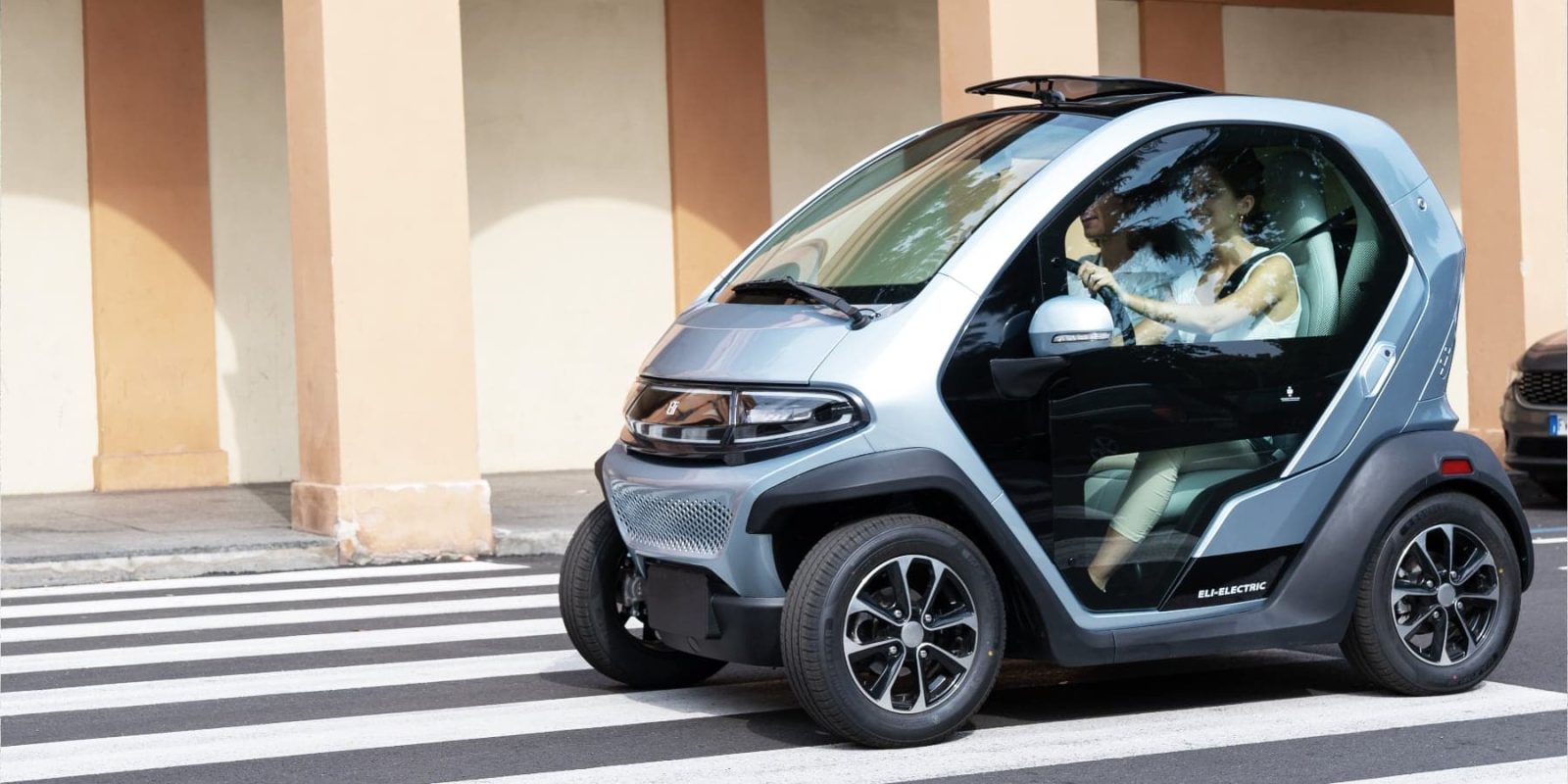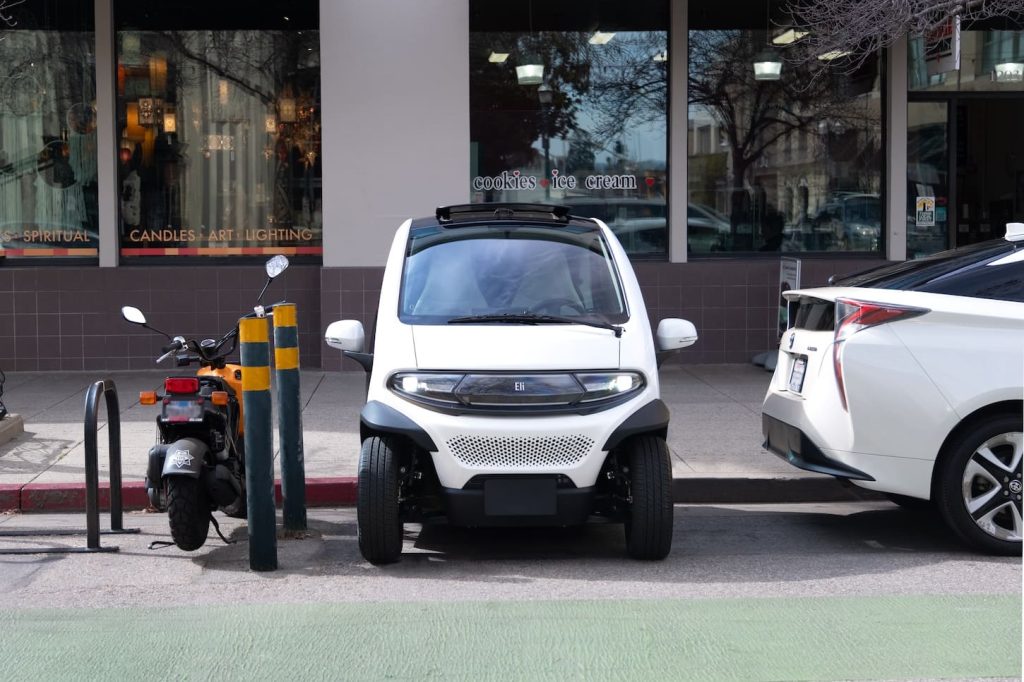
Let’s just face it, America. We’ve got a weight problem. No, not that weight problem. It’s the size of the cars. The best-selling vehicles in the US are all of the biggest, heaviest, and most oversized models available. But it doesn’t have to be that way. A new crop of tiny electric cars is changing the game and offering options we’ve never had before. Err, actually, I probably shouldn’t call them “cars”.
I’m talking about Low Speed Vehicles (LSVs), the official term for what many people call Neighborhood Electric Vehicles (NEVs).
Earlier this week, Eli Electric announced that it was opening pre-orders for its Eli ZERO, an electric vehicle so small that you can fit four of them in the same parking spot used by a large SUV. In fact, the little EV is roughly the size of just two motorcycles parked side by side.
That should make sense because just in the same way motorcycles are designed with the bare necessities to carry a single passenger, LSVs are generally the same idea, but for two passengers (or occasionally four passengers).
And at just US $11,900, the Eli Zero is finally an LSV that is affordable compared to most of the offerings we’ve seen in the past. Sure, I love me a nice GEM. But those suckers start at $15k, and the price jumps to $25k when you add doors and a lithium-ion battery upgrade. To put it lightly, Eli is making waves with a new electric microcar that is priced at half of the previous main competition.

So how can these motorcycle-sized electric vehicles be priced at less than half the cost of even the cheapest electric cars available in the US? Because they’re not really cars, essentially.
As LSVs, these are classified as motor vehicles, but not in the same way as passenger cars. They have their own not inconsequential set of regulations but don’t have to meet higher standards such as highway crash testing ratings, etc.
They’re also not nearly as powerful, since they are federally limited to just 25 mph (40 km/h) top speeds. As long as they meet the regulations and can be certified as street legal, they’re allowed on nearly any road in the country that has a posted speed limit of 35 mph (56 km/h) or less. That’s most of the roads in any city, which is why they’re so popular as urban vehicles.
And don’t think that since they aren’t cars, that you won’t get a car-like experience. The Eli Zero, for example, has a pile of features that should be familiar to any car owner, such as heat and air-conditioning, reverse camera, parking radar sensors, keyless unlocking/starting, power steering, and more. You even have the option of installing a Sony infotainment center with CarPlay or Android Auto integration.

The point is, LSVs may not be very fast, but for places where you’re not going to be driving very fast anyway (i.e. cities), the top speed just doesn’t matter that much. In Manhattan, for example, the average speed of traffic is just 7 mph (11 km/h). What’s more important is the size, the price, and the convenience.
When it comes to size, you just can’t beat LSVs. They’re small enough to park just about anywhere, and they don’t take up much space in your garage (if you’re lucky enough to have one of those ‘garage’ things in a city).
The pricing also makes them incredibly affordable as a replacement for a real car. Not only are they cheaper to buy outright, but they’re also much cheaper to own. They likely have reduced insurance costs (depending on your state), and the electricy cost to charge them pennies… literally. A full charge on many of these models might be slightly over one dollar, though most people don’t start from a completely empty battery. That means that a recharge likely costs you roughly the amount of loose change you’ve got dangling around in the bottom of your pocket. The cost of one single solitary gallon of gasoline would put around 200 to 300 miles of range into that Eli Zero, for example.
And lastly, let’s talk convenience. Owning an electric car is already fairly convenient because you don’t have many of the same maintenance concerns as combustion engine cars. But an LSV is even easier since you don’t even have the complicated systems that keep Teslas spending so much time at the service center. You get a few nice features like keyless ignition, but these aren’t the same rolling supercomputers as modern cars, meaning you’re giving up your self-driving and other high-tech features in exchange for reduced complexity.

The average city dweller is already on the fence about whether or not to even own a car, mostly due to the inconvenience of car ownership in the city. But if you can get the convenience of having your own weather-sealed ride yet don’t have to figure out how to park a boat downtown, then suddenly the equation becomes a lot more intriguiging.
And for suburbanites who are trying to decide on whether or not to get that second car, perhaps an LSV is the right choice. I generally recommend an electric bike as a replacement second car, but I understand that many people simply don’t want the two-wheeled lifestyle. If you can get something the size of two bikes, but that has glass and metal around you, (not to mention DOT seatbelts and anti-lock brakes), then perhaps an LSV is the right compromise.
There are simply so many advantages here, and I’ve barely scratched the surface. For now, these are still largely seen as quirky little vehicles, and I get it. They are quirky. But that’s also part of the fun charm. Most Cybertruck owners won’t admit it, but they bought that monstrosity because it was quirky and unique, just in a different way. Quirky vehicles can be fun because they mix things up, solving the same transportation problem in a new and fun way.
As the pool of available LSVs in the US grows, so too will the demand. The numbers are already growing, albeit slowly. I’ve touted the Eli ZERO several times in this article, largely because it’s fresh in the news (I’m not connected to the company, and I have no financial incentive – I just like the thing). But there are other models out there. The previously mentioned GEMs have offered solid LSV solutions in the US for decades. Wink Motors is a fairly new startup with interesting offerings, and has a new model coming to the US soon. Several golf cart makers have LSV versions, though they’re open-air vehicles that don’t have many of the same advantages of enclosed microcars. But the point is, there are more options than ever before.
Now, if we could just get the US government to get it together and include LSVs in the federal tax incentives for electric vehicles, that’d be something! These are electric vehicles, just smaller ones. And if the US truly cares about all the benefits of electric vehicles, then helping people turn these things into daily drivers with four-figure price tags will go a long way.
So here it is, the end of my rant. There are a lot of cars on the road, but few can match the utility per pound that LSVs offer.
If you live in a city and have been looking for an affordable electric car, here it is, in all its glory. And there it goes, at no faster than a federally-limited 25 mph.
